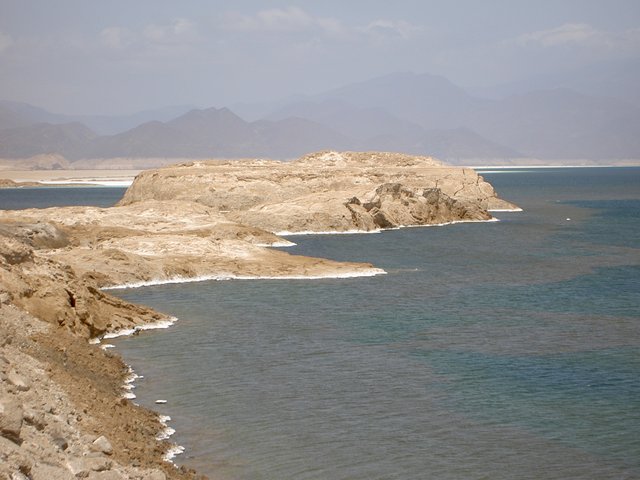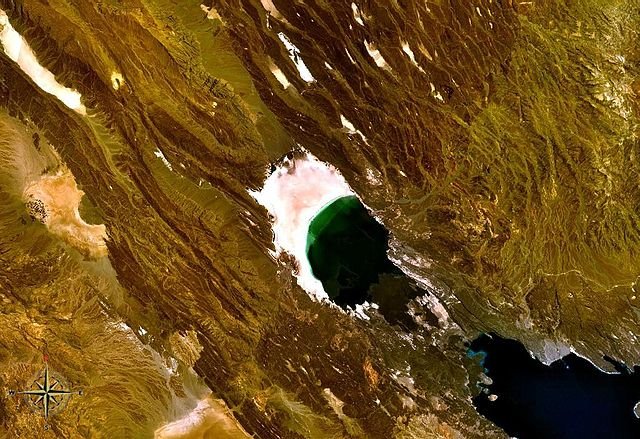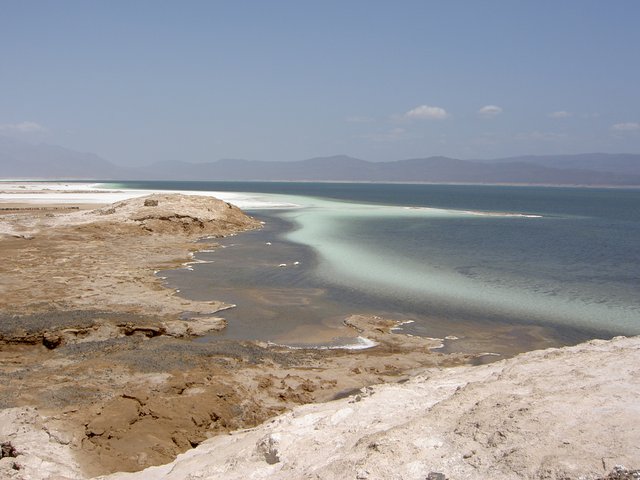Wonders of nature. Lake Assal

The most salty lake on earth, which, perhaps, will split Africa in two.
Once the ancient Romans were so jaded with the wonders of Africa that, in response to the story of the next traveler, they politely remarked: "Well, in Africa you always meet something new." Today from many tourists you can hear a rash statement that miracles in Africa are no more.
And then it's good to remember about the lake Assal. For the first time it was visited by Europeans only in the 1920s, but the lake even then stood out from a number of similar ones. This is the lowest point of the African continent — 155 meters below sea level. The summer air temperature reaches 57 ° C, which makes it the hottest place. It is also the salt water body on Earth, 10 times saltier than the ocean and much more salty than the Dead Sea.
In addition, Lake Assal is one of the most inhospitable places on the planet. On the surrounding lake of the bare hills of black with a white lava blaze, roasted by the sun, only the spiky that has just got here grows. The birds do not sing here; Even a lizard will not run along the shore. The sadness of death reigns everywhere.
Palette of colors
And yet this place has unearthly beauty. The flat banks are covered with salt, dazzlingly shining in the sun, and the clear water of intense turquoise color. On the surface of the water floating tender crusts of salt, shaped like a fan or palm branches, painted with mineral impurities in a variety of colors, from pale green to purple. On the shore scattered cabbage-like formations of salt.
By all miracles Lake Assal is obliged to its geographical position. It is located in Djibouti, in one of the corners of the Afar triangle — the most restless place in the geological sense on Earth. Here, three large cracks of the earth's crust converge — the East African rift system, the Red Sea and the Gulf of Aden, so earthquakes are frequent.
Volcanic eruptions in the Afar triangle are also common, and for millions of years the molten magma rises, pushing the surface of the Earth and forming basalt plateaus. Such phenomena are usually observed at the bottom of the sea, as, for example, in the Atlantic, where the bottom is constantly updated along the line passing in the middle of the ocean. The Afar triangle would also have been hidden under the waves, had it not been for the mountains of Danakil, which had become a barrier to the Red Sea. In this area, there is a rare opportunity to see on land land crust with a structure that is characteristic of the ocean floor.

Replenishes Assal mostly from the sea. Water seeps through the rocks and drains down to the lake; Water is added to it, draining from the hills after short winter rains. Salts from sea water and soluble mineral substances washed on the way to the lake, continue to be added to those that have accumulated here for many centuries.
This place was not always so arid. Approximately 10,000 years ago, the climate was more humid and the water level was 80 meters higher than the current one. This is evidenced by shells of freshwater mollusks, which can be found in the hills along the former coastline.
Formation of the relief of East Africa
If you drive a wedge into a dry log from the end, the tension will spread along its entire length, causing cracks to appear in various places along the wood fiber, far from the place of the initial impact. This way one can depict the influence of geological events in the Afar triangle on the whole of East Africa.
According to the theory of plate tectonic motion, the earth's crust, or lithospheric, consists of half a dozen individual plates that float in the molten inner asthenosphere, or mantle. The plates bear the granite foundations of the continents and are surrounded by the constantly renewed basalt bottom of the oceans.
In some parts of the globe, the slabs creep one on top of the other, while in others, they diverge. The latter is observed at the junction of the African and Arabian plates, which began to diverge about 20 million years ago. This led to the formation of the Red Sea and the Gulf of Aden. It is easy to see the existence of such a movement by looking at the map: if the opposite banks reconciled, they would have exactly approached each other.

And only in one place they will not coincide — in the region of Djibouti and the Afar triangle. The earth's crust is pushed apart by molten magma, which rises from the mantle, presses upwards and sideways, filling the gap that forms and forming a new ocean floor. Once the Afar triangle was part of the Red Sea, but with the appearance along the present coast of the Danakil Range, it was cut off from the sea and gradually dried up. He is exposed to the same forces that form the seabed. Lava continues to tear out through the cracks and volcanic vents, for millions of years, widely and irresistibly pushing apart the sides of the triangle.
As a result of this same process, the deepest depression of the East African rift system was formed. Stretching 6400 kilometers from the Dead Sea to Mozambique, it cuts the globe along its circumference. Throughout the length of the volcanoes and frequent earthquakes are located. The thrust of molten magma caused the rise and thinning of the earth's crust in Ethiopia and Kenya. Unable to withstand the tension, the earth split along the weak spots, forming cracks 60 kilometers wide. The depth to which the earth has fallen can not always be determined, since many cracks are flooded with lava flows.

For reasons unknown to us, the East African rift system split and went in two different directions. Its western branch, curved through Uganda, Zaire and Zambia, was filled with extensive lakes (Albert, Tanganyika and Malawi). The eastern part of the rift, passing through Ethiopia, Kenya and Tanzania, is marked by small lakes with alkaline water, such as Natron, and along the fault line the grand volcanoes — Mount Kenya and the Kilimanjaro volcano. In Olduvai, among the volcanic slags were found the fossil remains of the most ancient ancestors of man, who lived about 2.5 million years ago.
Perhaps the most interesting lies not in the past, but in the future. If there really is a gap between the plates, then one day the African Horn will break away from Africa. However, geologists say that this will never happen. They believe that because of the expansion of the Atlantic Ocean, Africa will be pinned to Arabia, and the Red Sea may again close.
Congratulations! This post has been upvoted from the communal account, @minnowsupport, by Mamasetta from the Minnow Support Project. It's a witness project run by aggroed, ausbitbank, teamsteem, theprophet0, someguy123, neoxian, followbtcnews/crimsonclad, and netuoso. The goal is to help Steemit grow by supporting Minnows and creating a social network. Please find us in the Peace, Abundance, and Liberty Network (PALnet) Discord Channel. It's a completely public and open space to all members of the Steemit community who voluntarily choose to be there.
This post has received a 0.78 % upvote from @drotto thanks to: @banjo.
Congratulations @mamasetta! You have completed some achievement on Steemit and have been rewarded with new badge(s) :
Click on any badge to view your own Board of Honor on SteemitBoard.
For more information about SteemitBoard, click here
If you no longer want to receive notifications, reply to this comment with the word
STOPResteemed your article. This article was resteemed because you are part of the New Steemians project. You can learn more about it here: https://steemit.com/introduceyourself/@gaman/new-steemians-project-launch